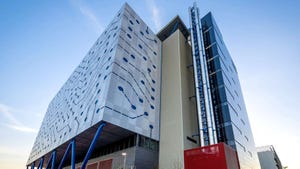AI-Driven Data Center Cooling Systems and TechnologiesAI-Driven Data Center Cooling Systems and Technologies
Omdia analyst Shen Wang takes a closer look at the latest advancements in data center cooling technologies.
August 16, 2024
.jpg?width=1280&auto=webp&quality=95&format=jpg&disable=upscale)
By Shen Wang, principal analyst, data center power & cooling systems, Omdia
In today's hyper-connected digital age, data centers are the cornerstone of our digital ecosystem, powering a vast array of networks, cloud computing and many other digital applications. However, the continuous operation of high-performance IT equipment generates substantial heat. This presents challenges that necessitate effective cooling solutions to ensure optimal operating conditions.
How Data Center Cooling Works
Designing data center cooling solutions involves considering the data center’s size, the thermal load of IT equipment and external environmental conditions. The choice between mechanical and passive cooling technologies can be tailored to each situation, either individually or in combination. In each thermal transmission cycle, the heat conduction medium can either be air-based or liquid-based absorbing heat through phase change or thermal conduction and transferring it through successive thermal cycles until it is expelled outside of the data center.
Data centers have developed a range of efficient cooling solutions with different functions and capacities. The next section provides an overview of these cooling technologies, outlining their specific functions and applications.
1. Air Handling Units (AHUs):
Indoor AHUs: These units provide room-level air control, often with horizontal airflow through the unit to the data center white space. They may utilize chilled water, direct or indirect evaporative cooling, or split direct expansion (DX) systems for heat rejection.
Outdoor AHUs: Larger systems installed outside the building, on rooftops or adjacent to the data center, providing precision cooling and humidity control. Heat rejection is achieved through chilled water, packaged DX, or direct/indirect evaporative air-side economizers.
2. Ceiling Mount
These cooling systems are installed above a drop ceiling or in unfinished ceiling areas to provide temperature and humidity control to the room. They can be ducted to adjacent rooms and utilize either DX or chilled water for heat rejection.
3. Mini-Split
These products offer precision cooling and humidity control with separate indoor and outdoor units. The indoor unit is wall mounted and provides direct cool air flow to the room, while the outdoor unit handles the condenser coils, fans, and compressor. They can be configured in one-to-one or one-to-many setups.
4. Row-Based (In-Row)
These are products positioned within a row of racks, usually between racks, to provide targeted cooling. They operate on DX or chilled water and are classified as active cooling equipment. In-row products are often deployed together with aisle containment.
5. Rear Door Heat Exchangers (RDHx)
Door-like products that attach to the back of rack enclosures, using DX or chilled water with in-built fans to remove heat from a single rack.
6. Perimeter Cooling
Perimeter is the most widely adopted cooling solution, providing air cooling and humidity control at a room level. This includes CRAHs (computer room air handler) and CRACs (computer room air conditioning) designed for downflow use on a raised floor or without a raised floor. Heat rejection is achieved through chilled water or DX systems.
7. Chillers
Chiller is the dedicated outdoor unit supplying chilled water for thermal management in data centers of varying sizes. This is the second largest category in data center thermal management.
8. Aisle Containment
This is the physical barrier that separates the supply and return air to and from IT equipment. This can be done at aisle, row, or rack level to improve air cooling system efficiency and air management.
9. Direct-to-Chip Liquid Cooling
Direct-to-Chip is the liquid cooling technology that removes heat at the chip level by placing a cold plate on the chip and utilizing liquid to flow inside the cold plate and transfer the heat. It can be single-phase or two-phase. Single-phase means heat is transferred via thermal conduction, while in two-phase, heat is removed via liquid vaporization.
10. Immersion Liquid Cooling
Immersion is another liquid cooling method that removes heat directly at the server level by immersing an entire server in a container filled with dielectric liquid coolant. It can be single-phase or two-phase immersion cooling depending on how heat is removed.
Advancements in AI Data Center Cooling
The rapid advancement of AI has led to an unprecedented increase in data processing and computing demands, driving a significant evolution in data center cooling methods. In this era, traditional cooling methods are increasingly unable to handle the heat generated by the dense computing clusters and high-performance hardware required for AI applications. This has driven more innovative cooling solutions tailored to the needs of AI data centers.
Compared to traditional data centers, cooling in AI data centers is significantly different. addressing optimized efficiency, greater capacity and increased intelligence. Traditional data centers often rely on room-level air cooling systems such as perimeter cooling, fans and air conditioning to manage the temperature throughout the space. However, when faced with the high-density heat generated by AI computing, these methods can become inefficient and inadequate.
In contrast, the cooling solutions that AI data centers would employ tend to be more precise and powerful, such as direct-to-chip and immersion liquid cooling, or RDHx and in-row cooling, which allow for efficient heat exchange. More importantly, AI data center cooling systems incorporate AI algorithms which can dynamically adjust cooling tactics based on real-time variables such as workload, ambient temperature and other factors. This not only improves cooling efficiency, but also significantly reduces energy consumption.
AI-driven predictive maintenance is becoming necessary in this era, realized through massive data analysis from sensors and historical information, enabling proactive measures against unexpected downtime and costly repairs, ensuring the continued reliability and performance of critical AI applications.
The Future of Data Center Cooling
Looking ahead, the future of data center cooling promises a deeper transformation to meet escalating computing demands and sustainability challenges. Advanced artificial intelligence algorithms will be deeply integrated into cooling systems to achieve unparalleled automation and intelligence. Real-time data analytics will enable accurate prediction and adjustment of cooling strategies to dynamically adapt to fluctuating workloads, optimizing energy efficiency and system reliability.
Liquid cooling, especially direct-to-chip, will become dominant in the foreseeable future due to its superior thermal conductivity, support for high-density computing environments and cost-effectiveness. The large-scale deployment of such technologies will significantly reduce the power consumption and carbon footprint of data centers. In addition, heat recovery systems that convert waste heat into a heat source for building heating or agriculture will be widely adopted, further advancing the concept of green data centers and creating new value.
Data centers are also exploring ways to harmonize with the natural environment, by using geothermal, seawater cooling and passive cooling techniques to reduce dependence on mechanical cooling. When combined with smart architectural design principles, data centers will become more environmentally friendly and can seamlessly integrate into the infrastructure of smart cities.
About the Author
You May Also Like







